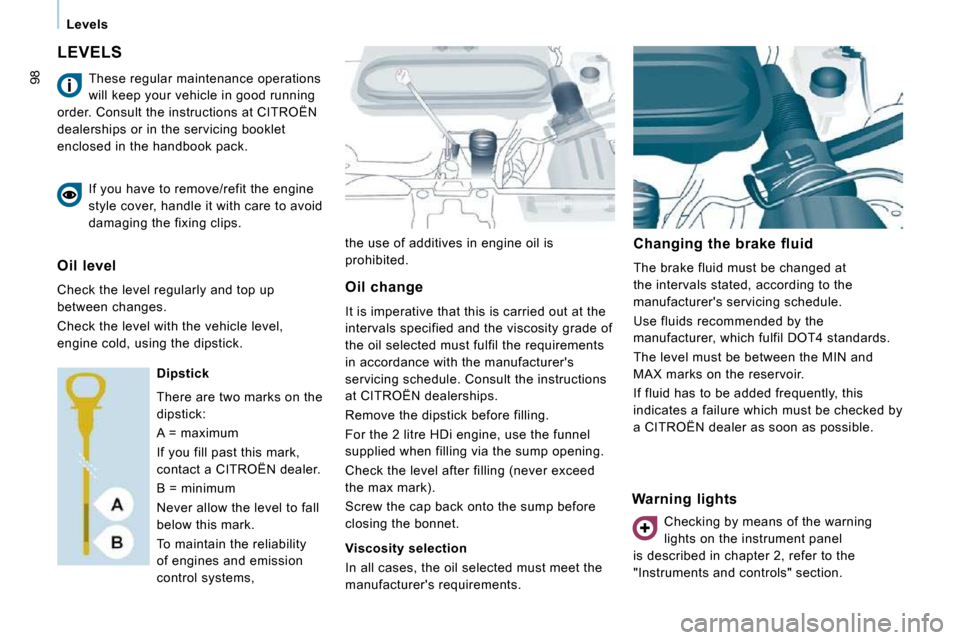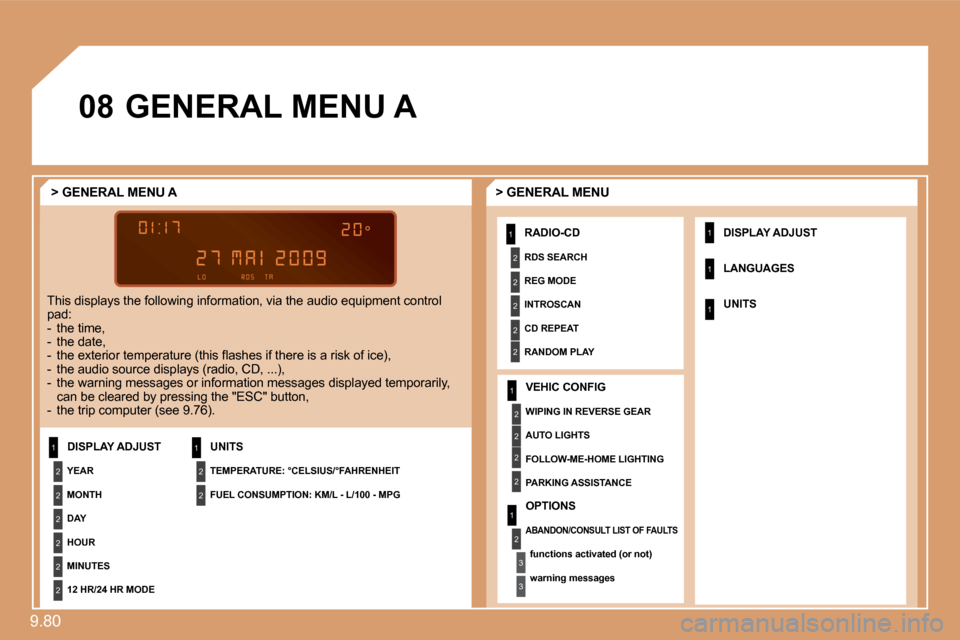warning lights Citroen JUMPY DAG 2009.5 2.G User Guide
[x] Cancel search | Manufacturer: CITROEN, Model Year: 2009.5, Model line: JUMPY DAG, Model: Citroen JUMPY DAG 2009.5 2.GPages: 221, PDF Size: 11.09 MB
Page 69 of 221

ABS
ABS
Driving safety
HORN
Press the centre of the steering wheel.
ANTI-LOCK BRAKING SYSTEM (ABS - EBFD)
The ABS and EBFD (electronic brake force
distribution) systems improve the stability
and manoeuvrability of your vehicle on
braking, in particular on poor or slippery
surfaces.
The ABS prevents locking of the wheels,
the EBFD provides control of the braking
pressure wheel by wheel. Good practice
The anti-lock braking system comes into
operation automatically when there is a risk
of wheel lock. It does not reduce the braking
distance.
On very slippery surfaces (ice, oil, etc...)
the ABS may increase the braking distance.
When braking in an emergency, do not
hesitate to press the brake pedal firmly,
without releasing the pressure, even on a
slippery surface, you will then be able to
continue to manoeuvre the vehicle to avoid
an obstacle.
Normal operation of the ABS may be felt by
slight vibration of the brake pedal.
When changing wheels (tyres and rims),
ensure that these are recommended by
CITROËN.
If this warning light comes on,
together with the brake and STOP
warning lights, accompanied by
an audible signal and a message
on the display, it indicates a malfunction of
the electronic brake force distribution which
could result in a loss of control of the vehicle
on braking.
Stop immediately.
EMERGENCY BRAKING ASSISTANCE SYSTEM (EBA)
In an emergency, this system enables the
optimum braking pressure to be reached
more quickly, press the pedal firmly without
releasing it.
It is triggered by the speed at which the brake
pedal is activated.
This alters the resistance of the brake pedal
under your foot.
If this warning light comes on,
accompanied by an audible signal
and a message on the display,
it indicates a malfunction of the
ABS which could result in a loss of control of
the vehicle on braking. In both cases, contact a CITROËN dealer.
To prolong the operation of the emergency
braking assistance system: keep your foot
on the brake pedal.
Page 75 of 221

86
Air bags Disarming
The passenger's front air bag alone can be
disarmed:
- With the ignition switched off , insert
the key into the passenger air bag
disarming switch,
- turn it to the "OFF" position,
- then remove the key keeping the slot in this position.
Front air bags
The front air bags are incorporated in the
centre of the steering wheel for the driver
and in the fascia for the front passenger.
Reactivation
In the
"OFF" position, the passenger air
bag will not be triggered in the event of an
impact.
As soon as the child seat is removed, turn
the air bag slot to the "ON" position to
re-activate the air bag and thus ensure the
safety of your passenger in the event of an
impact. To ensure the safety of your child, it
is essential to disarm the passenger
air bag when you install a rear-facing child
seat on the front passenger seat. Otherwise,
the child would risk being killed or seriously
injured if the air bag were to inflate.
The air bag warning light on the
instrument panel is lit throughout
the period of disarming.
Activation
They are deployed simultaneously, unless the
passenger's front air bag has been disarmed,
in the event of a serious front impact applied
to all or part of the front impact zone
A in the
longitudinal centreline of the vehicle on a
horizontal plane directed from the front towards
the rear of the vehicle.
The front air bag inflates between the front
occupant of the vehicle and the fascia to
cushion his forward movement. If this warning light comes on,
accompanied by an audible signal
and a message on the display,
contact a CITROËN dealer to
have the system checked.
Front air bag fault
If the two air bag warning lights are lit
continuously, do not install a rear-
facing child seat. Consult a CITROËN
dealer.
Page 92 of 221

98
Levels
LEVELS
the use of additives in engine oil is
prohibited. Changing the brake fluid
The brake fluid must be changed at
the intervals stated, according to the
manufacturer's servicing schedule.
Use fluids recommended by the
manufacturer, which fulfil DOT4 standards.
The level must be between the MIN and
MAX marks on the reservoir.
If fluid has to be added frequently, this
indicates a failure which must be checked by
a CITROËN dealer as soon as possible.
Warning lights
These regular maintenance operations
will keep your vehicle in good running
order. Consult the instructions at CITROËN
dealerships or in the servicing booklet
enclosed in the handbook pack.
If you have to remove/refit the engine
style cover, handle it with care to avoid
damaging the fixing clips.
Oil level
Check the level regularly and top up
between changes.
Check the level with the vehicle level,
engine cold, using the dipstick. Dipstick
There are two marks on the
dipstick:
A = maximum
If you fill past this mark,
contact a CITROËN dealer.
B = minimum
Never allow the level to fall
below this mark.
To maintain the reliability
of engines and emission
control systems, Oil change
It is imperative that this is carried out at the
intervals specified and the viscosity grade of
the oil selected must fulfil the requirements
in accordance with the manufacturer's
servicing schedule. Consult the instructions
at CITROËN dealerships.
Remove the dipstick before filling.
For the 2 litre HDi engine, use the funnel
supplied when filling via the sump opening.
Check the level after filling (never exceed
the max mark).
Screw the cap back onto the sump before
closing the bonnet.
Viscosity selection
In all cases, the oil selected must meet the
manufacturer's requirements.
Checking by means of the warning
lights on the instrument panel
is described in chapter 2, refer to the
"Instruments and controls" section.
Page 213 of 221

9.80
�0�8
1
2
2
2
2
2
2
1
2
2
1
2
2
2
2
2
1
2
2
1
2
3
3
2
2
1
1
1
GENERAL MENU A
> GENERAL MENU > GENERAL MENU A
This displays the following information, via the audio equipment control pad: - the time, - the date, � � �-� � �t�h�e� �e�x�t�e�r�i�o�r� �t�e�m�p�e�r�a�t�u�r�e� �(�t�h�i�s� �fl� �a�s�h�e�s� �i�f� �t�h�e�r�e� �i�s� �a� �r�i�s�k� �o�f� �i�c�e�)�,� - the audio source displays (radio, CD, ...), - the warning messages or information messages d isplayed temporarily, can be cleared by pressing the "ESC" button, - the trip computer (see 9.76).
DISPLAY ADJUST UNITS
RADIO-CD
REG MODE
RDS SEARCH
INTROSCAN
CD REPEAT
RANDOM PLAY
� � �W�I�P�I�N�G� �I�N� �R�E�V�E�R�S�E� �G�E�A�R� �
PARKING ASSISTANCE
OPTIONS
AUTO LIGHTS
FOLLOW-ME-HOME LIGHTING
� � �V�E�H�I�C� �C�O�N�F�I�G�
ABANDON/CONSULT LIST OF FAULTS
� � �f�u�n�c�t�i�o�n�s� �a�c�t�i�v�a�t�e�d� �(�o�r� �n�o�t�)� �
� � �w�a�r�n�i�n�g� �m�e�s�s�a�g�e�s� � � �
DISPLAY ADJUST
LANGUAGES
UNITS
YEAR
MONTH
DAY
HOUR
MINUTES
� � �1�2� �H�R�/�2�4� �H�R� �M�O�D�E� � �
� � �T�E�M�P�E�R�A�T�U�R�E�:� �°�C�E�L�S�I�U�S�/�°�F�A�H�R�E�N�H�E�I�T� �
� � �F�U�E�L� �C�O�N�S�U�M�P�T�I�O�N�:� �K�M�/�L� �-� �L�/�1�0�0� �-� �M�P�G� � � �